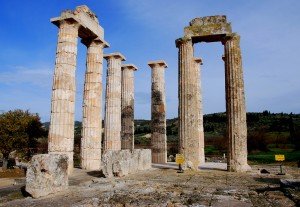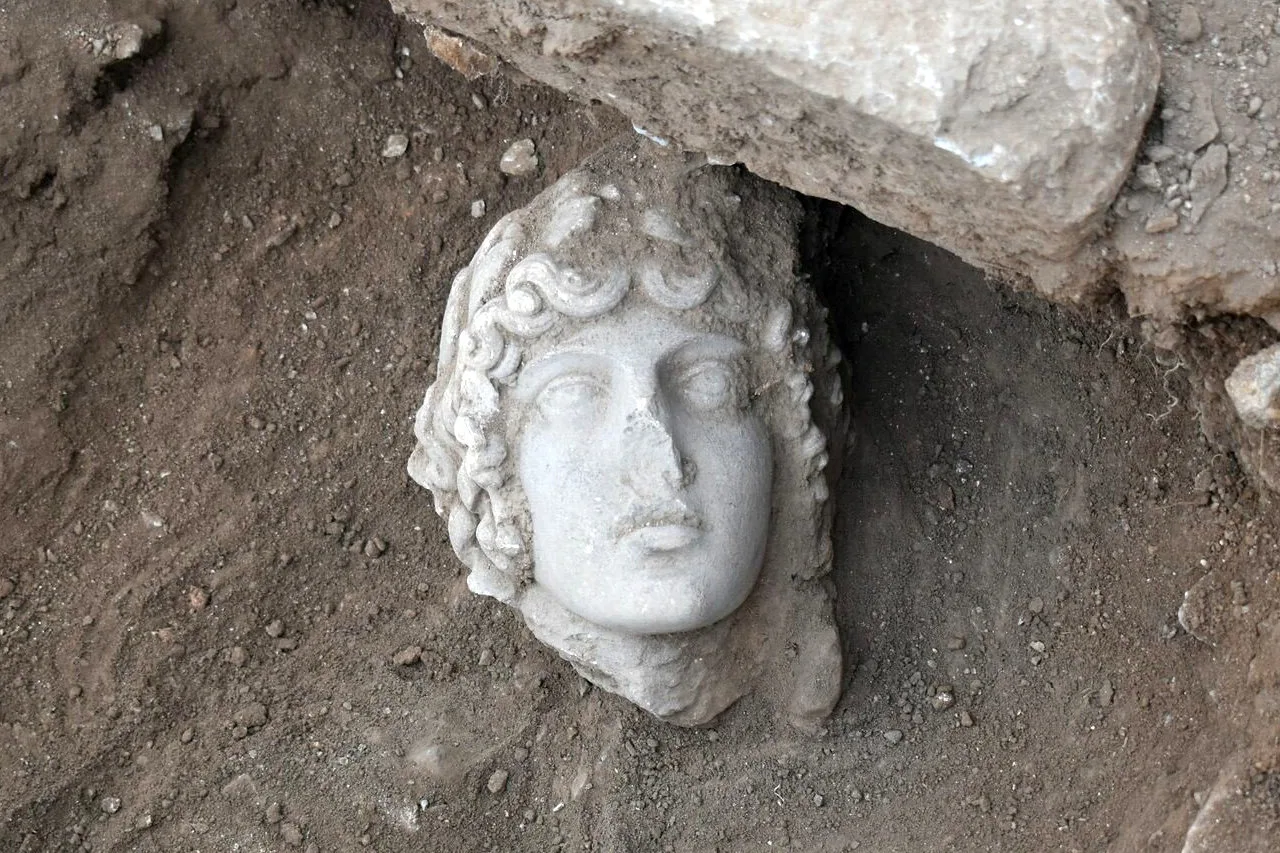NEMEA – Mythology, Archaeological Sites
Nemea
Nemea began in 573bC and took place every two years, according to the tradition, during the second full moon, after the summer’s solstice and comprised a part of the grand, Panhellenic games. The games took place inside the sacred space of the Temple of Nemeos Zeus, where there was a racecourse and a stadium housing 40.000 spectators. Their winner was crowned with celery wreaths and the names of the great winners still lie engraved on the rocks of the stadium.
Nemeas history that governs the establishment of the Nemea comes from very far, from the times of the expedition of the seven of Thebe. God Dionysus, protector of the land of Kadmos-Thebe, wanting to deter the expedition, destroyed everything on the way of the generals, burning the Cereals and poisoning the springs.
As they were reaching Nemea, hungry and thirsty, the soldiers met Limnos’ exiled queen Ipsipili, nutrient of Opheltes, son of Nemea’s priest Lycourgos and were led by her to a spring nearby. Ipsipili, wanting to offer entreaty to God Dionysus in order to leave the spring clean, left young Opheltes on the wild celeries. A snake bit Opheltes, though, and he died. Thus, the prophesy of the oracle of Delphi was fulfilled for young Opheltes. The Oracle has prophesized that something really nasty would happen if young Opheltes touched the ground before he was able to walk.
So, in order to placate the Gods, but also the Minister of the Temple, the seven of Thebe founded the Nemea in honor of the event. The oracle Tiresias, who accompanied the expedition, advised the generals not to continue from Thebe, because the omens were not in favor of them and named Opheltes “archimoro” (beginning of the bad fate). The Generals did not listen, the expedition continued and nobody returned.
In the summer 1996, thanks to the attempts of both the Municipality of Nemea and the American Archaeological School, the games revived after 2,300 years.
It’s considered to be an international sporting event that is held every four years, which aims to originally restore the connection of today with the ancient Greek athletic ideal.
People of 12 to 88 years of age, regardless of sex, color, beliefs, performance exempt from stress of distinction or of coming first, come to Nemea as spectators, athletes, to feel the joy of participation, the feeling of bonding of countries and people, the splendor of noble rivalry. Everything is plain, firm, ritual, without extremities. The Nemea is a challenge and an invitation for the man of today. The Nemea was a Panhellenic feast in honor of Zeus, in the valley of Nemea, situated between the plains of Cleonas and Fliounta.
The games lasted for many days and-as foe all Panhellenic events-they always took place in a period of truce. After the sacrifice to Nemeos Zeus, the nudist and equestrian games started, which were stadium, dolichos, equestrian road, road of men-at arms, wrestling, boxing, pangration, pentathlon, chariot. For the nudist games there were three categories of athletes, children, adolescents and men.
The Nemea continued to have a deathly character, revealed by black clothes worn by Ellanodikes as well as by the park-bocage of cypresses around the sanctuary of Zeus. As in the Olympia, musical games were not included in the Nemea. Firstly, the city of the Cleons controlled the games, but later on Argos undertook their organization.
Mythology
Nemea, beyond the hills, the river Aesopos’ daughter-nymph Nemea welcomes you…
- The Lion of Nemea
According to the Greek Mythology the Lion of Nemea was a lion that lived in the area of Nemea and scared people away. He was Typhoon and Echidna’s or Orthros and Chimaera’s descendant. There still exists the view that he fell from the Moon and was Zeus and Moon’s descendant: “I come from the beautiful-haired Moon, who, shaking in horror tossed from above her the quadromorph lion and threw it in Nemea to satisfy the venerable Hera”. This beast was eventually killed by Hercules.
The killing of the Leo and its skinning was the first of the 12 deeds assigned to Hercules by Evristheas.
 Leo had a very thick skin that could not be pierced by any weapon. At first, Hercules used his bow and sword, but with no result. He finally wrestled, himself, bare-handed with the beast and suffocated it, …“the beast dashes on me, its legs do not touch the ground anymore, but it staggers and falls. I stroke it so herd on the head that a thick cloud covered its eyes…” Then he tried to skin it, but that was also impossible. Goddess Athena recommended using the animal’s own teeth, as Hercules did, finally, managing to subtract its skin… “I did it, I winkled out its pelt, which was harder than iron and covered my shoulders with it. Thus, I had shield that no homicidal enemy arrow could penetrate.
Leo had a very thick skin that could not be pierced by any weapon. At first, Hercules used his bow and sword, but with no result. He finally wrestled, himself, bare-handed with the beast and suffocated it, …“the beast dashes on me, its legs do not touch the ground anymore, but it staggers and falls. I stroke it so herd on the head that a thick cloud covered its eyes…” Then he tried to skin it, but that was also impossible. Goddess Athena recommended using the animal’s own teeth, as Hercules did, finally, managing to subtract its skin… “I did it, I winkled out its pelt, which was harder than iron and covered my shoulders with it. Thus, I had shield that no homicidal enemy arrow could penetrate.
The hero wore the lion skin and took it to Evristheas to tell him he had carried out his first mission. When he saw him entering, Evristheas was terrified, thinking it was the lion itself and hided in a storage jar. Hercules kept the lion skin and always wore it from then on as a shield, known as “leonti”.
The Lion’s dead body was transferred from the Gods to the sky and formed the constellation Leo.
Archaeological Sites
Archaeological Park
… “In the entrance of the archaeological site, which is an arcade with carved rocks and remarkable rocks leading us from the light of the twilight, suddenly appears before us the stadium. It is like hearing the footsteps and the shouts of thousands of people competing or cheering for the winners. Nearby, there is the Temple of Zeus with columns around, but mainly with those columns resisting time, standing bright white, shedding their light to the area…”
A nice surprise awaits the visitor of Ancient Nemea. Care, organization, politeness and modern facilities constitute the archaeological site a model of development.
The Temple of Zeus in Nemea develops in the beginning of the 6th BC century, when Nemea Panhellenic games were established, in an area where human action was traced since the prehistoric years.
The first Temple of Zeus and the first two phases of the Heroon (war memorial) date back to the archaic years. In the 5th BC century the nine domestic treasures are constructed. Near the end of the 4th BC century, during a great construction project, the latest Temple of Zeus, the bathroom, the guest-room, the Stadium and the third part of the Heroon are built.
Protector of the games, as in Olympia, was Zeus, who, being the God of the sky and rain, was already worshipped by the Dorians, since their settlement on the summit of mount Apesa (today’s Fouka), which dominates the plain.
The most important part of the sanctuary was the Temple of Zeus, which was built after the mid 4th BC century and was a Doric pavilion with 6 columns in its narrow sides and 12 in its long ones. One of them and two of the front building still remain standing.
 There still exist vertebra of the columns, many parts of the roof, triglyph parts and metopes. On the east of the Temple lies a big altar from which an inclined level led to the Temple. The roof of the cella was supported by a line of columns of Corinthian style, which covered the three sides of it.
There still exist vertebra of the columns, many parts of the roof, triglyph parts and metopes. On the east of the Temple lies a big altar from which an inclined level led to the Temple. The roof of the cella was supported by a line of columns of Corinthian style, which covered the three sides of it.
Nearby, there have also been found traces of the ancient town on Flious, where the sanctuaries of Ivy, Demeter and Persephone lie, as well as a Temple of Asklepios, on which they have nowadays constructed the Church of Zoodochos Pighi.
The Cemetery of the Nightingales
One of the most important Mycenaean cemeteries of Peloponnesus some km west of Nemea, near the small village of Nightingales, Mycenaean graves were excavated between 1978-1980, mostly robbed, belonging to the Mycenaean town Arethirea.
The Museum
The Museum was founded during the excavating project of the University of California in Berkeley, thanks to the generosity of Mr. Rudolph Peterson. The Museum was donated to the Greek Government and was inaugurated in 1984.
The Collections include:
- Collections of views about Nemea by sightseers-visitors of the 18th and 20th century.
- Collections of coins of ancient visitors of Nemea.
- Collections of objects relating to sporting activities of Nemea.
- Prehistoric findings (pottery, tools, weapons, etc) from prehistoric positions in the area of Nemea.
- Collections of pots and jewellery from the Mycenaean cemetery in Nightingales and from the settlement in Saint Irene.
- Collection of architectonic pieces of monuments of archaeological sites and other positions.
- Collection of Carvings (of Nemea, Fliounta,Petri).
Museum Phone: 27460-22739
Churches
- Saint George’s Chapel
In Koutsomodis’ settlement of Ancient Nemea you find the chapel of Saint George, already related to the religious history of the area. It consists of one room with an ecclesiastical tiled roof, a wooden screen and marvellous icons, painted in 1932, and constitutes the jewel and pride of the settlement.
- Virgin Mary of the Rock
In the entrance of Nemea, on the left, on the steep rock, which rises impressively, lies, in harmony with the stone, Virgin Mary of the rock, whose history is connected with the older and legendary Monastery and Episcopate Polyfegous, built according to its stamp around 1633.
The entrance of the Monastery is stone-built, proud, with its west side touching the rock and the left supported on a wall. It is worth mentioning the hermit’s cell of Polyfegous, situated stuck inside the cave on the summit of the mountain, with murals of the Lord’s Ipapanti and of Saint George, which date to the 11th-12th century.
- The Routes-roads of the Wine of Peloponnesus
The roads of the wine of Peloponnesus invite you to memorable experiences of images, perfumes and tastes. They invite you to wineries, which will guide you to the enchanting world of wine and famous vineyards that produce a great variety of quality wines.









